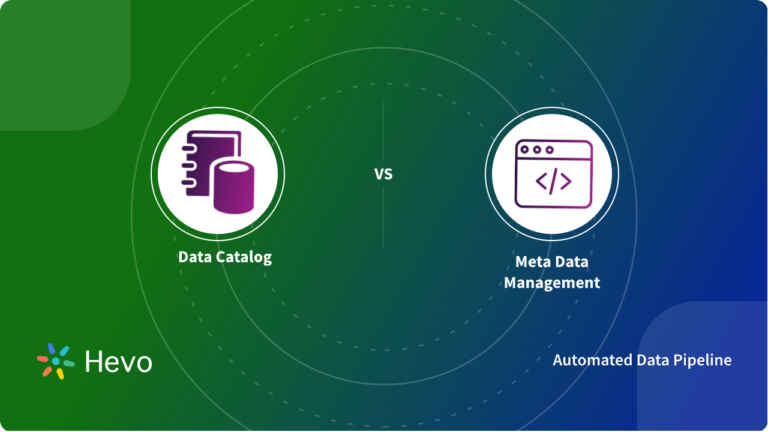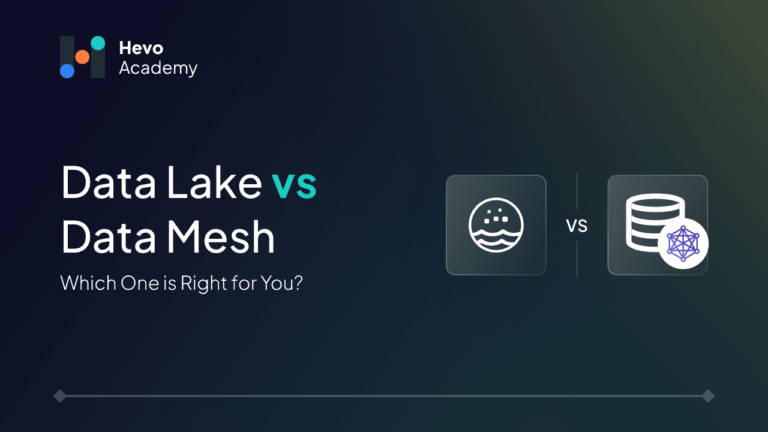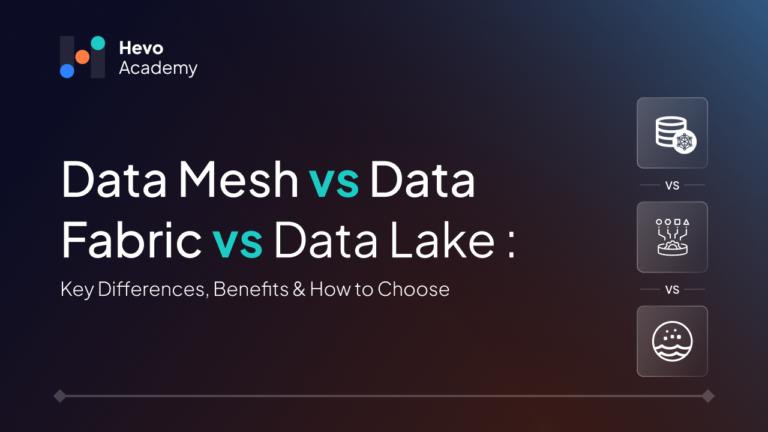When we think about managing data effectively, two terms often pop up: metadata and master data. But what do they really mean, and why are they so important? In this blog, I’ll dive into these two concepts, breaking down how they work, why metadata vs master data differ, and how each plays a crucial role in building a solid data strategy.
Table of Contents
Whether you want to streamline your data or make better business decisions, understanding metadata and master data is a game-changer. Let’s explore how each fits into the big picture of data success.
What is Data Management?
Data management encompasses all disciplines related to managing and organizing data, which is a valuable resource for an organization for in-depth research, analysis, and decision-making for business growth and success.
To understand data management, we first need to understand data and its various types. Data refers to information obtained through observations, measurements, logs, study, or analysis. It may include facts, numbers, names, figures, or even descriptions of objects. Data is often structured into graphs, charts, and tables. There are generally four types of data, and each serves a unique function in any organization.
The four types of data are:
- Transactional Data: Transactional data operates on a much larger scale and contains secured information about organization operations. Transactional data is often generated, stored, and used in operational and/or transactional applications with safe and restrictive access.
- Master Data: Master data represents core entities shared across organizations that give context to businesses, such as customers, employees, products, location, materials, etc., and support transactions. Master data is developed, maintained, and stored in a way that allows several applications to access it for specific business processes or activities in an organization.
- Reference Data: Reference data is reliable and widely available information that categorizes data, correlates it with consistent values, and provides context to master data. Master data is linked to reference data and depends on it, whereas reference data does not depend on master data.
- Metadata: Metadata is data summarized in a format that leads to detailed data. It contains the definitions of business metadata, operational metadata, data warehouse, data for mapping from the operational environment to the data warehouse, and various algorithms for summarization.
Looking for the right solution to manage your metadata and master data effectively? Hevo’s no-code platform simplifies data integration and ensures smooth data management. Try Hevo and empower your team to:
- Integrate data seamlessly from 150+ sources (including 60+ free sources).
- Leverage easy-to-use drag-and-drop features and custom Python scripts for advanced data transformations.
- Benefit from a robust security framework with SOC2 Compliance, ensuring risk management for cloud-based systems.
Join 2000+ customers who trust Hevo to modernize their data infrastructure and streamline their data processes.
Get Started with Hevo for FreeWhat is Metadata?
Metadata is information about other important and unstructured data in an organization. It provides structure, context, and meaning to data, enhancing its quality, accessibility, and analysis. Metadata is like the header of columns in a spreadsheet. Data dictionary tools help manage metadata by providing a structured way to define, catalog, and organize data elements, ensuring consistency and clarity.
A basic example of metadata in context with the database is storing information about a file’s author, date created, date of modification, timestamp, and size.
The Role of Metadata in Providing Context and Meaning to Data.
Metadata enhances data discovery, extraction, quality, understanding, accessibility, security, trustworthiness, and meaningful data analytics by providing context and meaning to data. As explained below, metadata plays various roles in providing context and meaning to data.
- Metadata is a directory that helps the decision support system locate the other data’s contents.
- Metadata aids in the decision-support process for the system’s data mapping process when data is transferred from an operational environment to a database environment.
- The ability to summarize highly summarized and current detailed data is made possible via metadata.
- Metadata is used in cleaning, extraction, and transformation tools.
- Metadata is used for query and reporting tools.
The Types of Metadata
For a thorough understanding of data and effective data management, metadata can be broadly categorized into four types including:
1. Business MetaData
It contains the business definition, data ownership information, and updated policies.
2. Technical MetaData
Names of database systems, names and sizes of tables and columns, data types, and permitted values are all included in technical metadata. It also includes structured data such as indices and primary and foreign key properties.
3. Descriptive Metadata
It describes the details of data, such as title, author, date, size, and other keywords.
4. Structural Metadata
It describes the data’s format, structure, and organization, such as schema and relationships.
5. Administrative Metadata
It provides administrative and maintenance data information, such as creation data, access controls, and various modifications over time.
6. Operational Metadata
Operational Metadata includes currency of data and data lineage. Currency of data tells whether the information is current, archived, or deleted. Data lineage tells about the history of data transformation and migration.
What is Master Data?
Master data is an organization’s organized, structured, crucial, and core data. It is shared among applications and systems across the organization for various business purposes. Master data is usually linked to reference data and looked up for references.
Master data contains data regarding customers, products, employees, materials, etc
A basic example of master data is employee master data, which is created and maintained so that both the organization’s human resources and time-tracking systems may access it, although for different purposes.
The Role of Master Data in Providing a Single, Authoritative Source of Truth.
Master Data Management (MDM) is a strategy method for harmonizing key data across an organization by consolidating and standardizing master data pieces. Master data contributes significantly to establishing a single, authoritative source of truth in the following ways, which serve as the foundation for informed decision-making and operational efficiency.
- Master Data establishes data integrity and consistency by omitting duplicate data, standardizing data format, and removing data discrepancies.
- While integrating and managing data from several acquisitions and adhering to industry regulations, MDM gives organizations the confidence to take on data challenges and maintain data quality simultaneously.
- Master data management helps make real-time data-driven decisions by breaking down data entities from various sources, extracting valuable insights, and uncovering data patterns in real-time.
- Master data management embraces the data governance culture by aligning data initiatives with business objectives and data governance policies.
The Types of Master Data
There are four types of Master Data Implementation according to different organizational needs.
1. The Consolidation Style
The consolidation style mainly assists with business intelligence (BI) and data warehousing projects. Because master data is created in downstream operational systems, this type of MDM is commonly referred to as downstream MD.
2. The Registry Style
The registry style is mainly utilized as an index for master data that is dispersed over distributed systems and is created in a distributed manner.
3. The Transaction or Centralized Style
When master data is created, saved, and retrieved from one or more MDM hubs, the centralized style is used. It is utilized in workflow or transaction scenarios, also called transaction style.
4. The Coexistence Style
The coexistence style is utilized mostly when master data authoring is decentralized, with a central hub hosting the “golden copy” maintenance. The central system publishes the “golden copy” master data to the subscriber systems.
Tabular Differences Between Metadata vs Master Data
Let’s compare Metadata vs Master Data in a tabular manner.
| Criteria | Metadata | Master Data |
| Definition | Data that describes other data | Critical data entities (e.g., customers, products) |
| Purpose | Data context and meaning that enable data discovery, quality, and governance | For core business data provide a single source of truth |
| Data Scope | All types of data | Specific master data entities |
| Examples | Data descriptions, definitions, relationships | Master data attributes and values |
| Role in Data Governance | Ensure data security and compliance | Ensures accuracy, integrity, accountability, and consistency |
| Usage | Improving data understanding, quality, and governance leads to better data decision-making and reduced errors. | For core business data, provide a single source of truth |
| Storage Location | Typically stored in catalogs or separate repositories | Typically stored in data warehouses or operational systems |
| Management Focus | Metadata management | Master Data Management (MDM) |
| Integration Complexities | Real-time integration with high volume, variety, and complex data | Seamless integration while maintaining data quality and governance |
Metadata vs Master Data Management
Both metadata and master data are vital for any data management strategy, be it for metadata or master data management, supporting data accuracy, consistency, and ease of access across an organization.
Metadata Management is all about managing metadata. It refers to practices and processes followed to manage metadata. Effective metadata management leads to discovering and organizing data. It helps organizations understand meaning, context, and relationships among data. It ensures data quality, security, and governance compliance.
Master Data Management is all about accurately and consistently managing master data. It helps organize an organization’s critical assets stored in master data, such as customer data, relationships, assets, products, suppliers, customer details, and hierarchies.
Let’s compare Metadata vs Master Data Management in a tabular manner.
| Criteria | Metadata Management | Masterdata Management |
| Data Scope | All data types and sources | Specific master data entities |
| Purpose | Improved data understanding, quality, and governance | Improved operational efficiency, customer experience |
| Data Governance Role | Supports data cataloging, lineage, and compliance. | Centralizes and harmonizes key business data. |
| Implementations Complexity | Data complexity, volume, and variety | Data quality, integration, and governance |
| Tools and Technology | Metadata repositories, catalogs, and tools | MDM software, data integration tools |
Role of Metadata vs Master Data in Data Governance
Metadata vs master data are critical to managing data as data is valuable. Successful data management aims to minimize risks while maximizing the ROI of businesses with effective data governance. Effective data governance is achieved by implementing both metadata vs master data management side by side. Metadata and Master data management both combine to help in data governance in the following ways:
- Data Management: Metadata vs Master data collaborate to handle data management and help gain a clear understanding of the meaning, context, and relationships of data with transparency.
- Data Security: Metadata vs Master data guarantees data privacy, security, compliance, and access control.
- Data Quality: The importance of metadata and master data in ensuring data quality cannot be understated, as they provide the foundational elements for accurate data reporting.
- Data Compliance: Metadata vs Master data helps mitigate risk with regulatory data compliance rules and regulations.
- Data Analytics: Metadata vs Master data helps with real-time accurate business insights and analytics, allowing data-driven and well-informed real-time decision-making.
When implementing a comprehensive data governance framework, understanding the distinction between metadata and master data is crucial for setting clear data management policies.
Conclusion
In summary, metadata vs master data are important and effectively implemented in an organization. Master data is itself crucial data for an organization, and metadata is required to describe and manage it. Together, these work to give a complete overview of customers, products, employees, and suppliers. Metadata vs master data can be leveraged for data management, business analytics, decision-making reporting, and driving business growth and success.
Schedule a personalized demo with Hevo for seamless data integration.
Frequently Asked Questions
1. What is the main difference between data and metadata?
Data is raw information, while metadata is data that describes or gives information about other data (e.g., file size, format, creation date).
2. What are the 3 types of master data?
The three types of master data are people data (customers, employees), product data (items, materials), and location data (addresses, regions).
3. What is the difference between metadata and reference data?
Metadata describes data properties (e.g., format, structure), whereas reference data standardizes the data (e.g., currency codes, country codes).
4. What is the difference between data and master data?
Data is general information, while master data refers to critical business entities that remain consistent across the organization (e.g., customer or product data).






